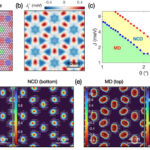2024-07-01 スイス連邦工科大学ローザンヌ校(EPFL)

Magnetite © EPFL/iStock
<関連情報>
- https://actu.epfl.ch/news/controlling-electronics-with-light-the-magnetite-b/
- https://www.pnas.org/doi/abs/10.1073/pnas.2316438121
- https://journals.aps.org/prb/abstract/10.1103/PhysRevB.96.104308
マグネタイトにおけるエネルギー調整電子光励起による隠れた相の超高速生成 Ultrafast generation of hidden phases via energy-tuned electronic photoexcitation in magnetite
B. Truc, P. Usai, F. Pennacchio, +7, and F. Carbone
Proceedings of the National Academy of Sciences Published:June 20, 2024
DOI:https://doi.org/10.1073/pnas.2316438121
Significance
In the quest of controlling materials’ properties on demand, light presents a promising avenue due to its ability to provide ultrafast control and induce phases of matter that are otherwise inaccessible through traditional adiabatic means. This unlocks states exhibiting tailored emergent properties, named hidden phases. Here, we demonstrate how to reach in the same system two distinct metastable structural hidden phases associated with different electronic properties. This manipulation is made possible by harnessing the strongly correlated nature of magnetite and employing two specific photon energies to photoexcite the system. Our study breaks ground for an approach to control matter at ultrafast timescale using tailored photon pulses.
Abstract
Phase transitions occurring in nonequilibrium conditions can evolve through high-energy intermediate states inaccessible via equilibrium adiabatic conditions. Because of the subtle nature of such hidden phases, their direct observation is extremely challenging and requires simultaneous visualization of matter at subpicoseconds and subpicometer scales. Here, we show that a magnetite crystal in the vicinity of its metal-to-insulator transition evolves through different hidden states when controlled via energy-tuned ultrashort laser pulses. By directly monitoring magnetite’s crystal structure with ultrafast electron diffraction, we found that upon near-infrared (800 nm) excitation, the trimeron charge/orbital ordering pattern is destroyed in favor of a phase-separated state made of cubic-metallic and monoclinic-insulating regions. On the contrary, visible light (400 nm) activates a photodoping charge transfer process that further promotes the long-range order of the trimerons by stabilizing the charge density wave fluctuations, leading to the reinforcement of the monoclinic insulating phase. Our results demonstrate that magnetite’s structure can evolve through completely different metastable hidden phases that can be reached long after the initial excitation has relaxed, breaking ground for a protocol to control emergent properties of matter.
マグネタイトにおける光誘起電子-フォノン相互作用による対称性禁制フォノンのコヒーレント生成 Coherent generation of symmetry-forbidden phonons by light-induced electron-phonon interactions in magnetite
S. Borroni, E. Baldini, V. M. Katukuri, A. Mann, K. Parlinski, D. Legut, C. Arrell, F. van Mourik, J. Teyssier, A. Kozlowski, P. Piekarz, O. V. Yazyev, A. M. Oleś, J. Lorenzana, and F. Carbone
Physical Review B Published: 19 September 2017
ABSTRACT
Symmetry breaking across phase transitions often causes changes in selection rules and emergence of optical modes which can be detected via spectroscopic techniques or generated coherently in pump-probe experiments. In second-order or weakly first-order transitions, fluctuations of the ordering field are present above the ordering temperature, giving rise to intriguing precursor phenomena, such as critical opalescence. Here, we demonstrate that in magnetite (Fe3O4) light excitation couples to the critical fluctuations of the charge order and coherently generates structural modes of the ordered phase above the critical temperature of the Verwey transition. Our findings are obtained by detecting coherent oscillations of the optical constants through ultrafast broadband spectroscopy and analyzing their dependence on temperature. To unveil the coupling between the structural modes and the electronic excitations, at the origin of the Verwey transition, we combine our results from pump-probe experiments with spontaneous Raman scattering data and theoretical calculations of both the phonon dispersion curves and the optical constants. Our methodology represents an effective tool to study the real-time dynamics of critical fluctuations across phase transitions.



